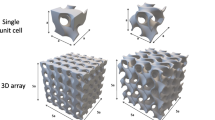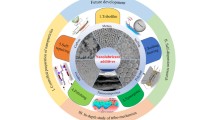Abstract
In this research, the effect of magnetic nano-fluids (Fe3O4) on the heat transfer enhancement in a pipe with laminar flows (Re numbers of 171, 228 and 285) were examined. Different heats (15.75 and 20.6 W) were applied to an acrylic pipe to analyse the effect of magnetic nano-fluids for transferring the heat and reducing the wall temperature on a non-metal material pipe. Variations of nano-particles (volume percentage) were used in the nano-fluids solution: 2, 3 and 4%, respectively. The magnetic nano-fluids (Fe3O4) were prepared from 32.5 g of FeCl3.6H2O (ferric chloride) and 12.7 g of FeCl2.4 H2O (ferrous chloride) by using a co-precipitation method. The material characterisations using XRD and FE-SEM confirmed that Fe3O4 single phase occurred and shown that the average size diameters of the nano-particles are within a range of 20-40 nm. The experimental results suggested that the cooling capability can be enhanced by adding magnetic nano-particles controlled by permanent magnet and increasing the heat transfer in the magnetic nano-fluids system. The aggregation of the magnetic nano-particles following the magnetic field applied from the permanent magnet increases the convection heat transfer from the heating source to the nano-fluids, and thus reducing the wall temperature of the acrylic pipe.










Similar content being viewed by others
Abbreviations
- A :
-
Area (m2)
- B :
-
Magnetic flux density (T)
- d :
-
Diameter (m)
- h :
-
Coefficient of convection (W/m2.oC)
- I :
-
Current generated by DC power supply (A)
- J :
-
Current density (A/m2)
- k :
-
Thermal conductivity (W/m.oC)
- l :
-
length of the pipe (m)
- Nu :
-
Nusselt number
- Q :
-
Heat generated by the heating source (W)
- q” :
-
Heat flux supplied to the pipe (W/m2)
- T :
-
Temperature (°C)
- V :
-
Voltage generated by DC power supply (V)
- μ :
-
Magnetic permeability
- f :
-
fluid
- i :
-
inner
- o :
-
outer
- p :
-
pipe
- w :
-
wall
References
Islam MR, Shabani B, Rosengarten G, Andrews J (2015) The potential of using nanofluids in PEM fuel cell cooling systems: A review. Renew Sust Energ Rev 48:523–539
Islam MR, Shabani B, Rosengarten G (2016) Nanofluids to improve the performance of PEM fuel cell cooling systems: A theoretical approach. Appl Energy 178:660–671
Zakaria I, Izmi W, Mamat A, Mamat R, Saidur R, Talib SA, Mohamed W (2016) Thermal analysis of Al2O3–water ethylene glycol mixture nanofluid for single PEM fuel cell cooling plate: An experimental study. Int J Hydrog Energy 41:5096–5112
Elmir M, Mehdaoui R, Mojtabi A (2012) Numerical simulation of cooling a solar cell by forced convection in the Presence of a Nanofluid. Energy Procedia 18:594–603
Mahian O, Kianifar A, Kalogirou SA, Pop I, Wongwises S (2013) A review of the applications of nanofluids in solar energy. Int J Heat Mass Transf 57:582–594
Kasaeian A, Eshghi AT, Sameti M (2015) A review on the applications of nanofluids in solar energy systems. Renew Sust Energ Rev 43:584–598
Wong KV, De Leon O (2010) Applications of Nanofluids: Current and Future. Advances in Mechanical Engineering 2:519659
Kole M, Dey TK (2010) Viscosity of alumina nanoparticles dispersed in car engine coolant. Exp Thermal Fluid Sci 34:677–683
Sidik NAC, Yazid MNAWM, Mamat R (2015) A review on the application of nanofluids in vehicle engine cooling system. International Communications in Heat and Mass Transfer 68:85–90
Putra N, Yanuar, Iskandar FN (2011) Application of nanofluids to a heat pipe liquid-block and the thermoelectric cooling of electronic equipment. Exp Thermal Fluid Sci 35:1274–1281
Ijam A, Saidur R (2012) Nanofluid as a coolant for electronic devices (cooling of electronic devices). Appl Therm Eng 32:76–82
Selvakumar P, Suresh S (2012) Convective performance of CuO/water nanofluid in an electronic heat sink. Exp Thermal Fluid Sci 40:57–63
Javadpour A, Najafi M, Javaherdeh K (2018) Effect of magnetic field on forced convection heat transfer of a non-Newtonian nanofluid through an annulus: an experimental study. Heat Mass Transf
Kumar A, Subudhi S (2018) Preparation, characteristics, convection and applications of magnetic nanofluids: A review. Heat Mass Transf 54:241–265
Khurana D, Choudhary R, Subudhi S (2017) A Critical review of forced convection heat transfer and pressure drop of Al2O3, TiO2 and CuO nanofluids. Heat Mass Transf 53:343–361
Jianguo C, Yulong D, Caiyun M (2014) Aqueous Al2O3 nanofluid: the important factor impacting convective heat transfer. Heat Mass Transf 50:1639–1648
Chavan D, Pise AT (2015) Experimental investigation of convective heat transfer agumentation using Al2O3/water nanofluid in circular pipe. Heat Mass Transf 51:1237–1246
Abu-Nada E (2009) Effects of variable viscosity and thermal conductivity of Al2O3–water nanofluid on heat transfer enhancement in natural convection. Int J Heat Fluid Flow 30:679–690
Hwang KS, Jang SP, Choi SUS (2009) Experimental Investigation of convective heat transfer agumentation using Al2O3/water nanofluid in circular pipe. Int J Heat Mass Transf 51:1237–1246
Murshed SMS, Leong KC, Yang C (2005) Enhanced thermal conductivity of TiO2—water based nanofluids. Int J Therm Sci 44:367–373
He Y, Jin Y, Chen H, Ding Y, Cang D, Lu H (2007) Heat transfer and flow behaviour of aqueous suspensions of TiO2 nanoparticles (nanofluids) flowing upward through a vertical pipe. Int J Heat Mass Transf 50:2272–2281
Duangthongsuk W, Wongwises S (2010) An experimental study on the heat transfer performance and pressure drop of TiO2-water nanofluids flowing under a turbulent flow regime. Int J Heat Mass Transf 53:334–344
Duangthongsuk W, Wongwises S (2009) Measurement of temperature-dependent thermal conductivity and viscosity of TiO2-water nanofluids. Exp Thermal Fluid Sci 33:706–714
Chopkar M, Das AK, Manna I, Das PK (2007) Pool boiling heat transfer characteristics of ZrO2–water nanofluids from a flat surface in a pool. Heat Mass Transf 44:999–1004
Esmaeilzadeh P, Hosseinpour N, Bahramian A, Fakhroueian Z, Arya S (2014) Effect of ZrO2 nanoparticles on the interfacial behavior of surfactant solutions at air–water and n-heptane–water interfaces. Fluid Phase Equilib 361:289–295
Battez A, Viesca JL, Gonzalez R, Garcia A, Reddyhoff T, Higuera-Garrido A (2014) Effect of Shear Rate, Temperature, and Particle Concentration on the Rheological Properties of ZnO and ZrO2Nanofluids. Tribol Trans 57:489–495
Sundar LS, Singh MK, Sousa ACM (2013) Investigation of thermal conductivity and viscosity of Fe3O4 nanofluid for heat transfer applications. International Communications in Heat and Mass Transfer 44:7–14
Bahiraei M, Hangi M (2015) Flow and heat transfer characteristics of magnetic nanofluids: A review. J Magn Magn Mater 374:125–138
Zhao G, Jian Y, Li F (2016) Streaming potential and heat transfer of nanofluids in microchannels in the presence of magnetic field. J Magn Magn Mater 407:75–82
Azizian R, Doroodchi E, Mckrell T, Buongiorno J, Hu L, Moghtaderi B (2014) Effect of magnetic field on laminar convective heat transfer of magnetite nanofluids. Int J Heat Mass Transf 68:94–109
Javad B, Amir HN (2011) Investigation of the different base fluid effects on the nanofluids heat transfer and pressure drop. Heat Mass Transf 47:1089–1099
Khairul MA, Doroodchi E, Azizian R, Moghtaderi B (2017) Thermal performance analysis of tunable magnetite nanofluids for an energy system. Appl Therm Eng 126:822–833
Sadeghinezhad E, Mehrali M, Akhiani AR, Latibari ST, Dolatshahi-Pirouz HSC, Metselaar MM (2017) Experimental study on heat transfer augmentation of graphene based ferrofluids in presence of magnetic field. Appl Therm Eng 114:415–427
Ashjaee M, Goharkhah M, Khadem LA, Ahmadi R (2015) Effect of magnetic field on the forced convection heat transfer and pressure drop of a magnetic nanofluid in a mfiniature heat sink. Heat Mass Transf 51:953–964
Fadaei F, Shahrokhi M, Dehkordi AM, Abbasi Z (2017) Heat transfer enhancement of Fe3O4 ferrofluids in the presence of magnetic field. J Magn Magn Mater 429:314–323
Ghasemian M, Ashrafi ZN, Goharkhah M, Ashjaee M (2015) Heat transfer characteristics of Fe3O4 ferrofluid flowing in a mini channel under constant and alternating magnetic fields. J Magn Magn Mater 381:158–167
Sheikhnejad Y, Hosseini R, Saffar-avval M (2015) Effect of different magnetic field distributions on laminar ferroconvection heat transfer in horizontal tube. J Magn Magn Mater 389:136–143
Sheikholeslami M, Gerdroodbary MB, Mousavi SV, Ganji DD, Moradi R (2018) Heat transfer enhancement of ferrofluid inside an 90 elbow channel by non-uniform magnetic field. J Magn Magn Mater 460:302–311
Hatami M, Zhou J, Geng J, Jing D (2018) Variable magnetic field (VMF) effect on the heat transfer of a half-annulus cavity filled by Fe3O4-water nanofluid under constant heat flux. J Magn Magn Mater 451:173–182
Asfer M, Mehta B, Kumar A, Khandekar S, Panigrahi PK (2016) Effect of magnetic field on laminar convective heat transfer characteristics of ferrofluid flowing through a circular stainless steel tube. Int J Heat Fluid Flow 59:74–86
Zonouzi SA, Khodabandeh R, Safarzadeh H, Aminfar H, Trushkina Y, Mohammadpourfard M, Ghanbarpour M, Alvarez GS (2018) Experimental investigation of the flow and heat transfer of magnetic nanofluid in a vertical tube in the presence of magnetic quadrupole field. Exp Thermal Fluid Sci 91:155–165
Li Y, Zhou J, Tung S, Schneider E, Xi S (2009) A review on development of nanofluid preparation and characterization. Powder Technol 196:89–101
Peng J, Zhou F, Liu L, L Tang LY, Chen W, Liu H, J Tang LW (2008) Preparation and characterization of PEG-PEI/Fe3O4 nano-magnetic fluid by co-precipitation method. Trans Nonferrous Metals Soc China 18:393–398
D. Meeker (2018) Finite Element Method Magnetics, Version 4.2, User’s Manual
Joubert JC, Sharifpur M, Solomon AB, Meyer JP (2017) Enhancement in heat transfer of a ferrofluid in a differentially heated square cavity through the use of permanent magnets. J Magn Magn Mater 443:149–158
Korolev VV, Arefyev IM, Blinov AV (2008) Heat capacity of superfine oxides of iron under applied magnetic fields. J Therm Anal Calorim 92:697–700
Lajvardi M, Moghimi-Rad J, Hadi I, Gavili A, Isfahani TD, Zabihi F, Sabbaghzadeh J (2010) Experimental investigation for enhanced ferrofluid heat transfer under magnetic field effect. J Magn Magn Mater 322:3508–3513
Bahiraei M, Hangi M (2013) Investigating the efficacy of magnetic nanofluid as a coolant in double-pipe heat exchanger in the presence of magnetic field. Energy Convers Manag 76:1125–1133
Acknowledgements
The authors would like to thank the Research Center for Physics-Indonesian Institute of Sciences (LIPI) for the facilities used in this research.
Author information
Authors and Affiliations
Corresponding author
Ethics declarations
Conflict of interest
On behalf of all authors, the corresponding author states that there is no conflict of interest.
Additional information
Publisher’s note
Springer Nature remains neutral with regard to jurisdictional claims in published maps and institutional affiliations.
Rights and permissions
About this article
Cite this article
Tetuko, A.P., Simbolon, S., Sitorus, T.G. et al. The effect of magnetic nano-fluids (Fe3O4) on the heat transfer enhancement in a pipe with laminar flow. Heat Mass Transfer 56, 65–74 (2020). https://doi.org/10.1007/s00231-019-02690-2
Received:
Accepted:
Published:
Issue Date:
DOI: https://doi.org/10.1007/s00231-019-02690-2




